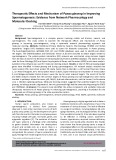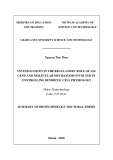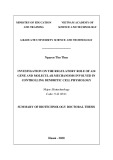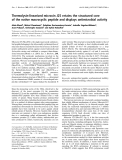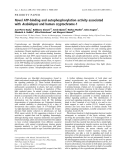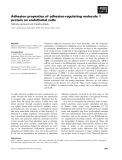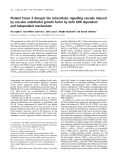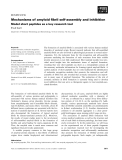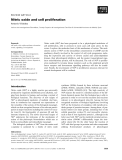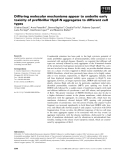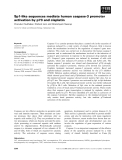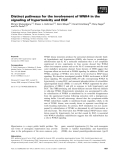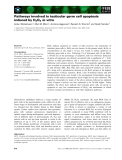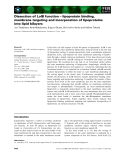
Molecular mechanisms involved
-
Spermatogenesis is a complex process involving mitotic cell division, meiosis, and spermiogenesis. This study aimed to examine the therapeutic effects and mechanisms of Panax ginseng in improving spermatogenesis, using a systematic network pharmacology approach and molecular docking.
 14p
14p  viharuno
viharuno
 03-01-2025
03-01-2025
 1
1
 1
1
 Download
Download
-
The objectives of the thesis: Investigate the role of A20 in regulating four physiological functions of DCs including maturation, cytokine secretion, migration and apoptosis. Investigate the effect of A20 on the regulating three molecular signals including NF-κB, STAT1 and STAT3 related to the physiological process of DCs.
 27p
27p  extraenglish
extraenglish
 24-05-2021
24-05-2021
 15
15
 4
4
 Download
Download
-
The objectives of the thesis: Investigate the role of A20 in regulating four physiological functions of DCs including maturation, cytokine secretion, migration and apoptosis; investigate the effect of A20 on the regulating three molecular signals including NF-κB, STAT1 and STAT3 related to the physiological process of DCs.
 27p
27p  capheviahe27
capheviahe27
 23-02-2021
23-02-2021
 15
15
 4
4
 Download
Download
-
Subunits (a, b and c) of the interleukin-2 receptor complex (IL-2R) are involved in both proliferative and activationinduced cell death (AICD) signaling of T cells. In addition, the signaling b and c chains are shared by other cytokines (e.g. IL-7, IL-9, IL-15). However, the molecular mechanisms responsible for recruiting/sorting the a chains to the signaling chains at the cell surface are not clear.
 10p
10p  research12
research12
 01-06-2013
01-06-2013
 30
30
 5
5
 Download
Download
-
Microcin J25 (MccJ25) is the single macrocyclic antimicro-bial peptidebelonging to the ribosomally synthesizedclass of microcins that are secreted byEnterobacteriaceae.Itshowed potent antibacterial activity against severalSalmonellaand Escherichiastrains and exhibited a compact three-dimen-sional structure [Blondet al. (2001) Eur. J. Biochem., 268, 2124–2133]. The molecular mechanisms involved in the biosynthesis, folding andmode of action of MccJ25 are still unknown.
 11p
11p  tumor12
tumor12
 22-04-2013
22-04-2013
 44
44
 2
2
 Download
Download
-
Cryptochromes are blue-light photoreceptors sharing sequence similarity to photolyases, a class of flavoenzymes catalyzing repair ofUV-damagedDNAvia electron transfer mechanisms. Despite significant amino acid sequence simi-larity in both catalytic and cofactor-binding domains, cryptochromes lack DNA repair functions associated with photolyases, and the molecular mechanism involved in cryptochrome signaling remains obscure.
 8p
8p  tumor12
tumor12
 20-04-2013
20-04-2013
 38
38
 3
3
 Download
Download
-
Peripheral nerve injury is normally followed by a robust regenerative response. Here we describe the early changes associated with injury from the initial rise in intracellular calcium and the subsequent activation of transcription factors and cytokines leading to an inflammatory reaction, and the expression of growth factors, cytokines, neuropeptides, and other secreted molecules involved in cell-to-cell communication promoting regen-eration and neurite outgrowth.
 11p
11p  awards
awards
 06-04-2013
06-04-2013
 35
35
 2
2
 Download
Download
-
Báo cáo khoa học: Adhesion properties of adhesion-regulating molecule 1 protein on endothelial cells
Numerous adhesion molecules have been described, and the molecular mechanisms of lymphocyte trafficking across the endothelium is starting to be elucidated. Identification of the molecules involved in the organoselec-tivity of this process would help in the targeting of drug therapy to specific tissues. Adhesion-regulating molecule-1 (ARM-1) is an adhesion-regulating molecule previously identified on T cells. It does not belong to any known families of adhesion molecules.
 12p
12p  awards
awards
 06-04-2013
06-04-2013
 35
35
 4
4
 Download
Download
-
The aromatic hydrocarbon receptor (AhR)-dependent pathway involved in 2,3,7,8-tetrachlorodibenzo-p-dioxin (TCDD)-induced immunotoxicity has been studied extensively, but the AhR-independent molecular mechan-ism has not. In previous studies we found that the AhR is not expressed in L-MAT, a human lymphoblastic T-cell line. In this report, we provide the following evidence that the protein kinase C (PKC)hactivity is func-tionally involved in the AhR-independent signal transduction mechanism that participates in the TCDD-induced L-MAT cell apoptosis....
 13p
13p  awards
awards
 05-04-2013
05-04-2013
 29
29
 2
2
 Download
Download
-
The mechanism by which the CXC chemokine platelet fac-tor 4 (PF-4) inhibits endothelial cell proliferation is unclear. The heparin-binding domains of PF-4 have been reported to prevent vascular endothelial growth factor 165 (VEGF165 ) andfibroblast growth factor 2 (FGF2) frominteractingwith their receptors. However, other studies have suggested that PF-4 acts via heparin-binding independent interactions. Here, we compared the effects of PF-4 on the signalling events involved in the proliferation induced by VEGF165 , which binds heparin, and by VEGF121 , which does not....
 0p
0p  awards
awards
 05-04-2013
05-04-2013
 37
37
 4
4
 Download
Download
-
The formation of amyloid fibrils is associated with various human medical disorders of unrelated origin. Recent research indicates that self-assembled amyloid fibrils are also involved in physiological processes in several micro-organisms. Yet, the molecular basis for the recognition and self-assembly processes mediating the formation of such structures from their soluble protein precursors is not fully understood.
 8p
8p  dell39
dell39
 27-03-2013
27-03-2013
 38
38
 5
5
 Download
Download
-
Nitric oxide (NO • ) has been proposed to be a physiological modulator of cell proliferation, able to promote in most cases cell cycle arrest. In this review I explore the molecular basis of this mechanism of action. The mod-ulatory action of NO • on the intracellular concentration of cGMP and the machinery directly involved in the control of cell cycle progression, inclu-ding the expression and activity of diverse cyclins and cyclin-dependent kinases,
 16p
16p  inspiron33
inspiron33
 26-03-2013
26-03-2013
 50
50
 4
4
 Download
Download
-
Considerable attention has been paid to the high cytotoxic potential of small, prefibrillar aggregates of proteins⁄peptides, either associated or not associated with amyloid diseases. Recently, we reported that different cell types are variously affected by early aggregates of the N-terminal domain of the prokaryotic hydrogenase maturation factor HypF (HypF-N), a pro-tein not involved in any disease.
 17p
17p  inspiron33
inspiron33
 26-03-2013
26-03-2013
 39
39
 4
4
 Download
Download
-
Caspase-3 is a cysteine protease that plays a central role in the execution of apoptosis induced by a wide variety of stimuli. However, little is known about the mechanisms involved in the regulation of caspase-3 gene tran-scription.
 14p
14p  media19
media19
 06-03-2013
06-03-2013
 33
33
 3
3
 Download
Download
-
Adhesive properties of endothelial cells are influenced by the thioldisulfide balance. However, the molecular mechanism of this effect is unclear, although recent observations indicate that integrin receptors may be direct targets for redox modulation. The purpose of this study was to examine whether protein disulfide isomerase (PDI) is directly involved in this pro-cess.
 11p
11p  media19
media19
 06-03-2013
06-03-2013
 59
59
 3
3
 Download
Download
-
WNK4 kinase mutations produce the autosomal dominant disorder famil-ial hyperkalemia and hypertension (FHH), also known as pseudohypo-aldosteronism type II, by a molecular mechanism that is not completely understood.
 12p
12p  media19
media19
 06-03-2013
06-03-2013
 43
43
 3
3
 Download
Download
-
EspB is a multifunctional protein associated with the type III secretion system of enterohaemorrhagic Escherichia coli, and interacts with various biomolecules includinga-catenin in the host cell. The binding of EspB to a-catenin is thought be involved in actin reorganization during bacterial infection, although the precise mechanism of this phenomenon is still unclear.
 8p
8p  vinaphone15
vinaphone15
 28-02-2013
28-02-2013
 30
30
 4
4
 Download
Download
-
The chitosanase fromStreptomycessp. N174 (CsnN174) is an inverting glycoside hydrolase belonging to family 46. Previous studies identified Asp40 as the general base residue. Mutation of Asp40 into glycine revealed an unexpectedly high residual activity. D40G mutation did not affect the stereochemical mechanism of catalysis or the mode of interaction with sub-strate.
 12p
12p  vinaphone15
vinaphone15
 27-02-2013
27-02-2013
 37
37
 2
2
 Download
Download
-
Escherichia colicells express at least 90 species of lipoprotein. LolB is one of the essential outer membrane lipoproteins, being involved in the last step of lipoprotein sorting. It accepts lipoproteins from a periplasmic molecular chaperone, LolA, and mediates the outer membrane anchoring of lipopro-teins through a largely unknown mechanism. It has been shown previously that a LolB derivative, mLolB, lacking an N-terminal acyl chain, can bind lipoproteins.
 9p
9p  vinaphone15
vinaphone15
 25-02-2013
25-02-2013
 45
45
 4
4
 Download
Download
-
In recent years, a considerable amount of research has been focused on estab-lishing the epigenetic mechanisms associated with DNA and the core histones. This effort is driven by the fact that epigenetics is intimately involved with genomics in a whole range of molecular processes. However, there is now a consensus that the epigenetics of the linker histones are just as important.
 13p
13p  viettel02
viettel02
 22-02-2013
22-02-2013
 46
46
 5
5
 Download
Download
CHỦ ĐỀ BẠN MUỐN TÌM









